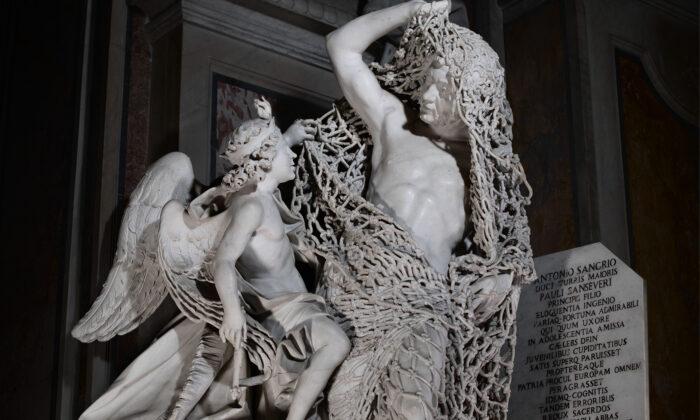A marble statue carved in the 18th century has become world-renowned for an “impossible” feature: a delicately draping fisherman’s net with detailed knots, rendered by hand entirely from marble, that looks so authentic it could be the real thing.
Il Disinganno, or “The Release from Deception,” is the magnum opus of the Genoese artist Francesco Queirolo, one of Italy’s leading 18th-century artists. The statue depicts an angel standing on a globe with a Bible at his feet, helping release a fisherman from a tangled fishing net. At first glance, the net seems to be made from real rope fibers. Upon closer inspection, the viewer can see that it is carved from a single block of marble and allegedly took Queirolo seven years to render.
The commissioned statue was completed in 1753 for the Italian nobleman Raimondo di Sangro for display at the renovated Sansevero Chapel in Naples, which was his family’s burial site.


Granite and marble are unpredictable materials and notoriously harder to carve than soapstone and alabaster, so a detailed marble statue exemplifies the artist’s skill.
The 18th-century stonemasons had access to tooth chisels, point chisels, drills, and rasps for working with marble, but even so, every chip from the marble block further increased the risk of committing an unfixable error.



The 18th-century Italian philosopher Giangiuseppe Origlia once described the statue as “the last and most trying test to which sculpture in marble can aspire.”
Three centuries on, Queirolo’s laborious work still receives the attention it deserves. Yet Il Disinganno is much more than an exhibition of expertise. The statue has both Biblical and non-religious significance.
The fisherman’s net is allegorical, symbolizing sin; as the angel frees the man from the net, so he liberates him from sin and shows him the way of the Lord. The Bible is open to a passage that reads, as translated from Latin, “I will break thy chain, the chain of the darkness and long night of which thou art a slave, so that thou might not be condemned with this world.”

Sansevero Chapel Museum explains that the statue also has secular meaning: a flame at the peak of the angel’s crown represents intellect, and the globe represents earthly passions. The open Bible has also been speculated to represent one of the three “great lights” of Freemasonry.
The light-refracting marble exudes a soft glow when polished, which accentuates the statue’s commentary on the battle between light and dark.
Il Disinganno was commissioned by di Sangro as a tribute to his father, the Duke of Torremaggiore, who died a priest after an eventful life. Queirolo’s incredible handiwork stuns tourists to this day but it is not the only masterpiece at the Sansevero Chapel.
The chapel houses an impressive 30 works of art in total, among them two similarly-detailed sculptures, “The Veiled Christ” by Giuseppe Sanmartino and “The Veiled Truth” by Antonio Corradini. Both were also completed in the early 1750s.





